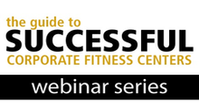 Fact:
Fact:
Generating reliable and accurate ROI on a corporate wellness program (I mean the whole thing--biometric screenings, absenteeism, presenteeism, HRA, wellness programming/activities, EAP, etc.) is really, really, really challenging. It requires lots of money, and lots of really smart people who’ve done that kind of work more than once or twice.
Fact:
Piecing out the impact of your corporate fitness center as a standalone element and then determining reliable and accurate ROI from that single piece of your overall strategy is, well, about as likely as spotting a unicorn.
You may be thinking to yourself, “But wait…I just saw an article on ROI for corporate fitness and that said 3:1 or 5:1 or 7:1 returns were possible. What’s with the unicorns and the impossibility of calculating ROI for corporate fitness?” It’s true that there is a continuous stream of articles about wellness ROI, and I suspect that there are business development teams for corporate wellness vendors who are armed to the gills with literature that “proves” why their service/product generates the best ROI for said client.
You see, there’s a lot of posturing in the corporate wellness market. The industry boasts some very powerful vendors--some of whom have the money and smarts to do the work required in order to generate reliable and accurate ROI. The industry also has a lot of other vendors who don’t have those tools, but who are still competing against those who do. Of this second group, there are two types: the vendor who reports ROI that is neither reliable nor accurate (unicorn anyone?), and the vendor who doesn’t report ROI.
Honestly, it’s time for employers to stop beating the ROI drum. (And I’m not the only one who thinks so. Read this article, or this one, or this one.)
ROI is hard to capture because corporate wellness is complex. There are a lot of moving parts, and to date, the industry has not been able to come together on metrics that are consistent. While this is true for most of the agreed-upon elements of a corporate wellness strategy, let’s just pull out corporate fitness to get a sense of the level of complexity we’re dealing with overall.
There are a variety of data points that can be captured for corporate fitness programs:
Membership:
Any vendor worth its salt will have some kind of prescreening process in place that, once completed, will allow the employee to join the fitness center. (Don’t just take my word for it; check out the standards provided by the American College of Sports Medicine in its Health/Fitness Facility Standards and Guidelines text.) Some vendors skip this process and everyone is instantly a member because they are employees. So the organization with this process instantly reports higher membership (100%!) than the vendor who requires a responsible process be completed prior to gaining membership.
Fitness assessments:
Field tests to assess the fitness level of a participant are highly variable and the chosen tests can sway the results depending on the population. It’s the nature of a field test; they aren’t as accurate as in the lab.
Visit data:
By now, software to track utilization is widely available at fairly minimal cost. However, if the business isn’t willing to pay for the software, fitness staff are left to track visit data with a manual tally. In either case, software or sign-in sheets, there are issues that can result in significant errors in data collection. Even if we forgive those errors or find a way to account for them, vendors count visit groups differently. “Frequent visitors” might be represented by members with at least one visit per month for vendor A, but vendor B may determine that at least one visit per week is required to achieve “frequent visitor” status.
Mixing those variables quickly creates a lot of inconsistency from one program to the next, making it exceptionally hard to compare apples to apples. Then you have other related data to consider—like gym membership subsidy and how to count employee-users of that benefit against or with your corporate fitness center users. Similarly, how do you capture the value, health benefits, and cost of employees who never step foot in the corporate fitness center but maintain their own exercise regimen at home?
So if your CFO isn’t going to sniff out ROI on your corporate wellness strategy or any of the individual elements like your worksite fitness center, what should you be looking to for data and outcomes you can believe? Rest assured, I’m not suggesting we revert back to all fluff and feel-good for employee wellness. As an alternative to traditional ROI, consider shifting your thinking toward value. To find out more about what I mean, check a two-part blog I wrote about a year ago where I outlined some ways to think about value from your corporate fitness center. You can read part one here and part two here.
If you're looking for how to build the very best corporate fitness center you can for your employees, consider our short webinar series: The Guide to Successful Corporate Fitness Centers.

